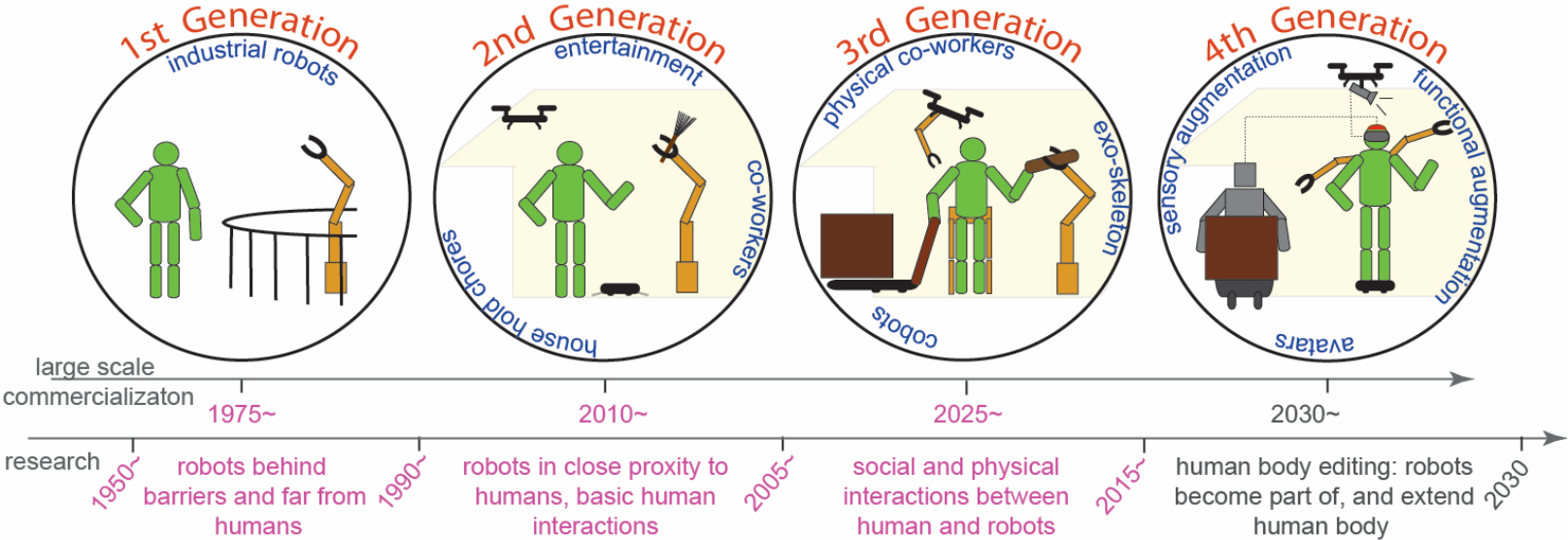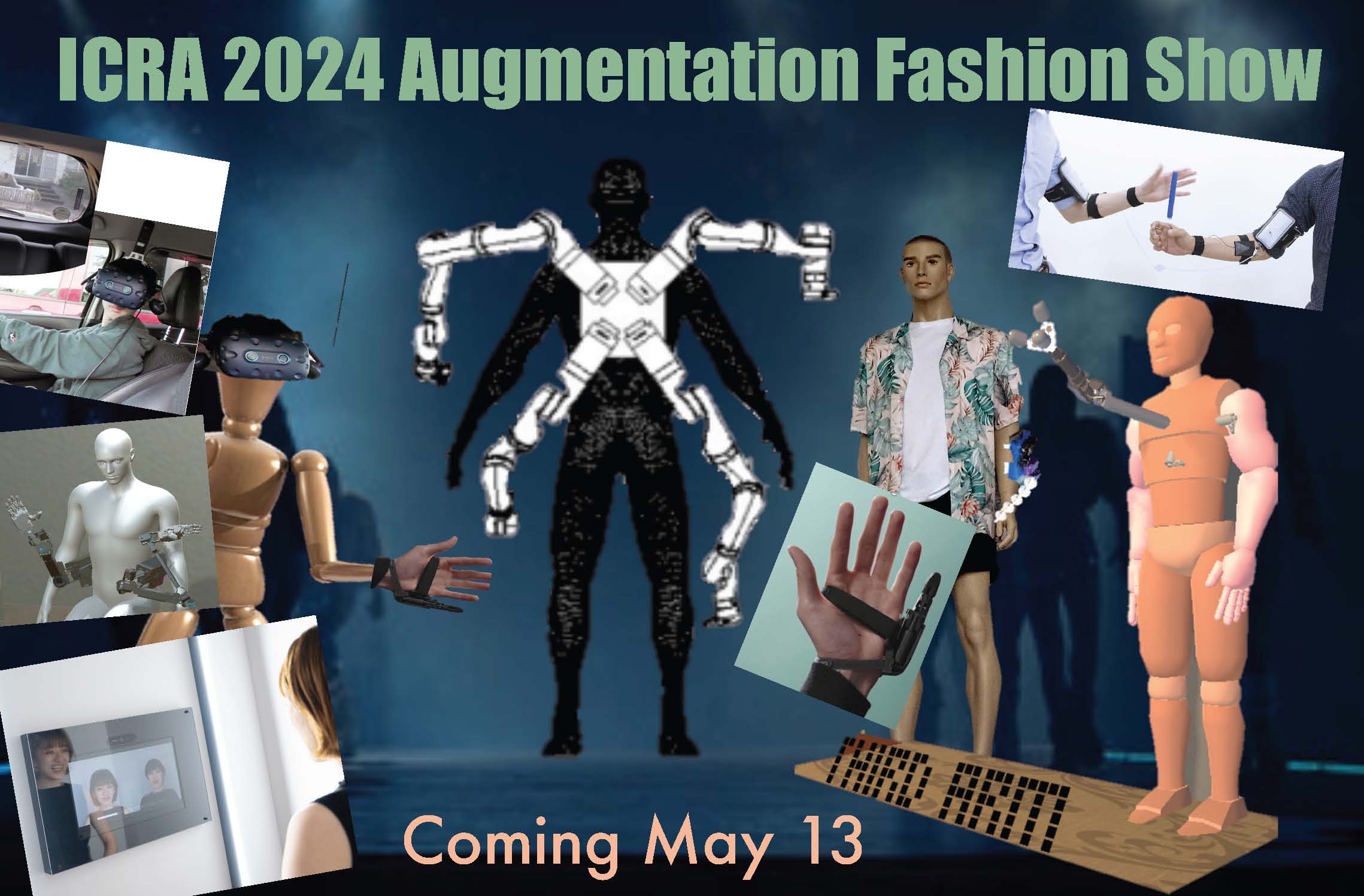The robotics, psychology and neuroscience of body augmentation
Date: 13 May 2024

Robotic body augmentation looks to use the sensing and actuation capabilities of robots to extend the human body's abilities. This novel form of robot-human interaction with supernumerary robot limbs (SRLs), avatars and artificial feedback devices blurs the physical boundaries between human and machine such that interdisciplinary understanding is required. This full-day workshop will provide a venue to discuss the challenges across the disciplines of robotics, psychology and neuroscience, as they associate to robotic body augmentation. It will build on the successful ICRA2023 workshop on “The robotics and neuroscience of supernumerary limbs”, extending the discussions to include the fields of psychology and virtual reality and explain how the integration of these fields with robotics and neuroscience is contributing to the creation of a new generation of robots and machines. Through a series of presentations, 10 leading experts in robotics, neuroscience, and psychology will present the state of the art research into robotic body augmentation. This will be complemented by a poster session as well as a moderated Q&A panel that will enable the audience to join the discussion on the challenges and directions for future research and industrial collaboration. The participants will be able to attend an augmentation fashion show and take part in a special competition session where they can augment their bodies with other participants in a virtual game.
Topic of interest
- Supernumerary limbs
- Soft and wearable robotics
- Embodiment
- Virtual reality and artificial haptics
- Sensory augmentation
- Shared and augmented control
Schedule
All in JST
Session 1: Neuroscience & psychology of augmentation
9:00-9:20: Wen Wen (Rikkyo University)
Title: Sense of agency in interaction
9:20-9:40: Rei Yasuda (University of Electrocommunication Tokyo)
Title: The 'independent' sixth finger project
9:40-10:00: Michiteru Kitazaki (Toyohashi University of Technology)
Title: Virtual co-embodiment with averaged motion and shared part control
Tea break (10:00-10:30)
10:30-10:50 Moderated discussion
Session 2: Robotic supernumerary limbs
11:00-11:20: Etienne Burdet (Imperial College London)
Title: Human capabilities for natural and robotic augmentation
11:20-11:40: Fernando Charith (Avatarin)
Title: Next-generation proactive remote support with telepresence robots
11:40-12:00: Harry Asada (MIT)
Title: Progress of MIT’s superlimbs research on two fronts: assisting astronauts in post-fall recovery on the moon; human-superlimb shared control using Lipschitz data analysis
12:00-12:20: Aude Billard (EPFL)
Title: Supernumerary control in a bipedal four-arm manipulation platform
12:20-12:40: Moderated discussion
Lunch (12:40-14:00)
Fashion show and interactive VR augmentation session (14:00-15:30)
Tea (15:30-15:40)
Session 3: Internal representation of body augmentation
15:40-16:00: Maki Sugimoto (Keio University)
Title: Design and verification of human augmentation in cyber-physical spaces
16:00-16:20: Anatole Lecuyer (INRIA)
Title: Embodying dissimilar avatars in extended reality
16:20-16:40: Shunichi Kasahara (Sony CSL)
Title: Cybernetic humanity: exploring the new humanity emerging from the integration of humans and computers
16:40-17:00: Moderated discussion
Concluding remarks and closing
Organizers
- Ganesh Gowrishankar, UM-CNRS Laboratoire d’Informatique, de Robotique et de Micro´electronique de Montpellier (LIRMM)
- Maki Sugimoto, Keio University
- Yoichi Miyawaki, University of Electro-Communications Tokyo
- Jonathan Eden, University of Melbourne
- Etienne Burdet, Imperial College London

Fashion show DEMO list
| University | Presenter | Device | Photo | Power | Space |
|---|---|---|---|---|---|
| UEC/CNRS | Sixth finger |  |
1 | 1 | |
| TUT/CNRS | Owl vision |  |
1 | 1 | |
| Keio | Virtual living lab |  |
1 | 1 | |
| Keio | Face drive |  |
1 | 1 | |
| Imperial College | MUVE backpack |  |
2 | 1 | |
| CUHK | CUHK arm |  |
1 | 1 | |
| MIT | Astronaut suite |